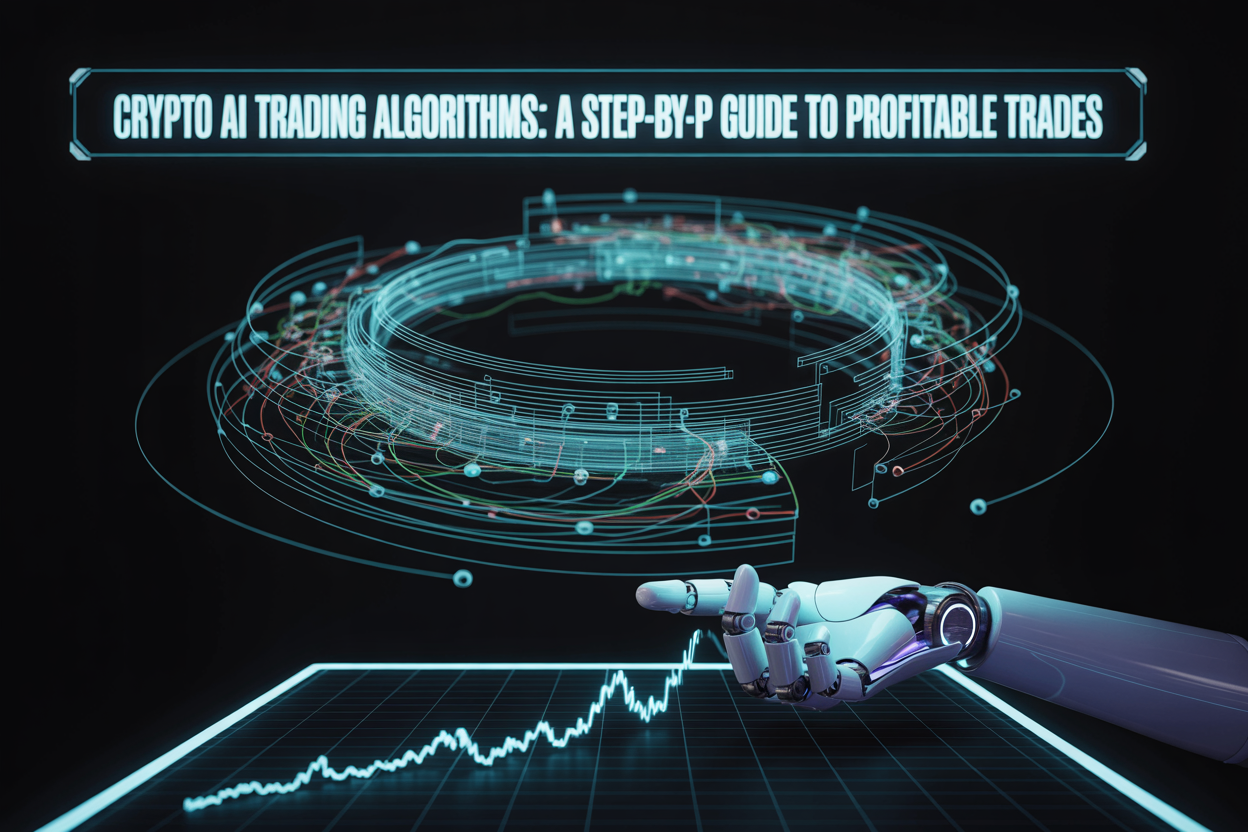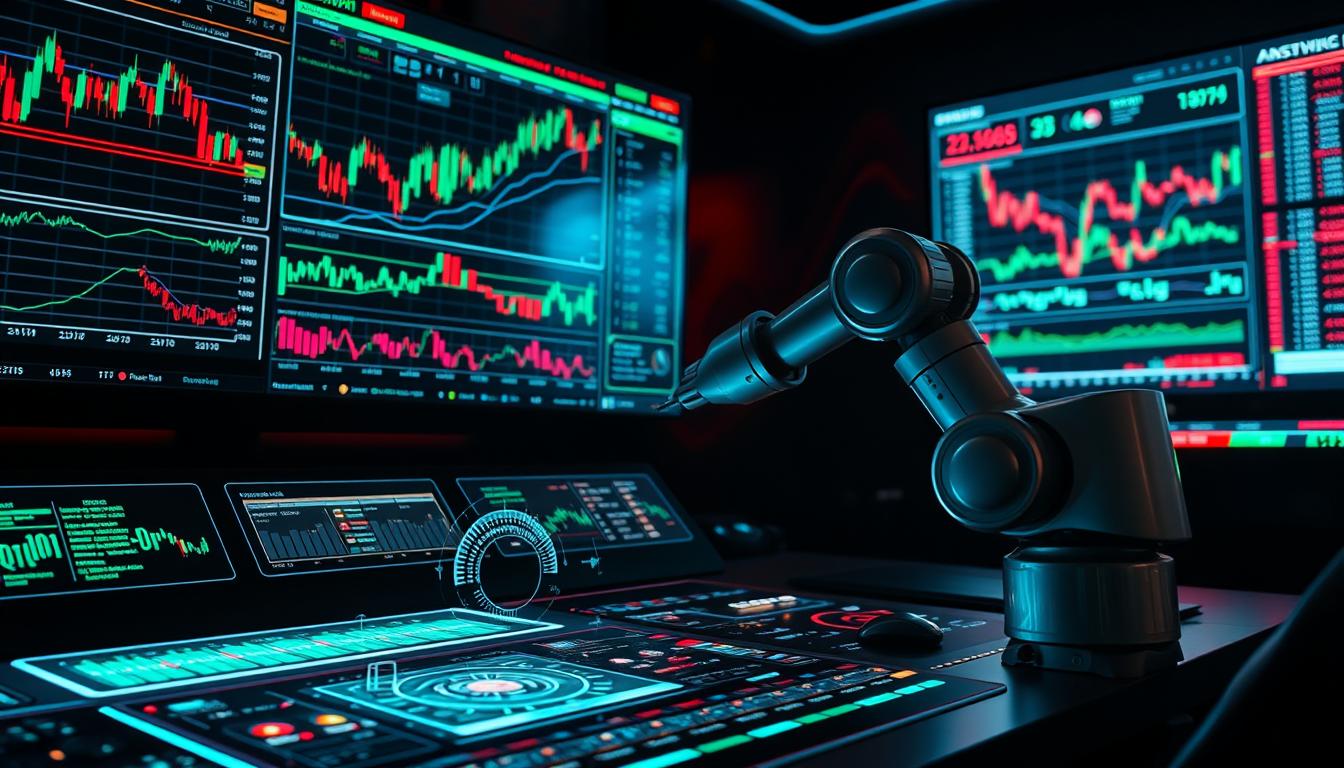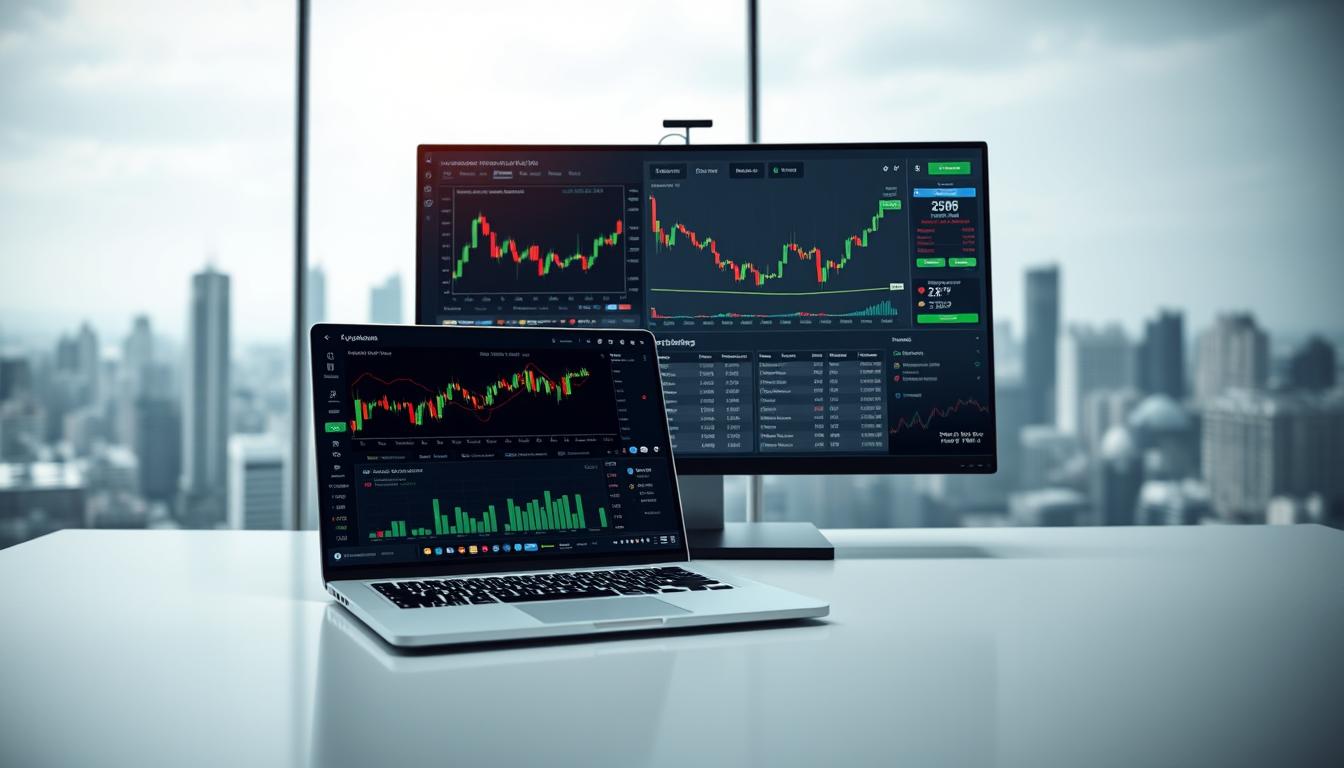Now Reading: Crypto AI Trading Algorithms: A Step-by-Step Guide to Profitable Trades
- 01
Crypto AI Trading Algorithms: A Step-by-Step Guide to Profitable Trades
Crypto AI Trading Algorithms: A Step-by-Step Guide to Profitable Trades

The world of cryptocurrency trading is becoming increasingly complex. This makes it hard for traders to make money. But, Crypto AI trading algorithms offer a solution. They use AI-powered trading tools to help traders stay ahead.

These advanced algorithms look at a lot of market data. They find patterns and make predictions. This helps traders make smart choices. Our guide will show you how to use Crypto AI trading algorithms to increase your profits.
Key Takeaways
- Understand the basics of Crypto AI trading algorithms
- Learn how to leverage AI-powered trading tools for profitable trades
- Discover the step-by-step process of using Crypto AI trading algorithms
- Maximize your trading profits with our expert guide
- Stay ahead of the competition with the latest Crypto AI trading algorithms
The Revolution of AI in Cryptocurrency Trading
Artificial intelligence (AI) has changed how we trade cryptocurrencies. It has made trading faster and more based on data.
The Paradigm Shift in Trading Methodologies
Old ways of trading, based on guesswork and manual checks, are fading. Now, algorithmic trading strategies powered by AI are taking over. These systems can handle huge amounts of data quickly, spotting trends and making predictions faster than humans.
Why Manual Trading Can’t Keep Up with Modern Markets
Manual trading is no longer effective in today’s fast markets. The crypto market never stops, with prices changing fast. Humans can’t keep up with AI’s speed and data analysis, making manual trading less useful.
The Competitive Advantage of Algorithmic Decision-Making
Algorithmic decision-making gives traders a big advantage. AI helps make smarter choices based on detailed data analysis. This boosts trade accuracy and risk management, leading to more complex strategies.
AI in cryptocurrency trading is more than a trend; it’s a paradigm shift changing financial markets. As AI gets better, its role in trading will expand, offering traders even more advanced tools.
Understanding Crypto AI Trading Algorithms
Crypto AI trading algorithms are a big step forward in trading cryptocurrencies. They help traders deal with complex markets in a smart way. These algorithms use artificial intelligence and machine learning to look at lots of data, find patterns, and predict what will happen next.
Defining AI-Powered Trading Systems
AI-powered trading systems automate trading by using advanced algorithms. These systems can look at many data points at once. They use data like past prices, trading volumes, and market mood to make smart trading choices.
Key characteristics of AI-powered trading systems include:
- Ability to analyze large datasets
- Capacity to learn from historical data
- Adaptability to changing market conditions
Core Components of Effective Trading Algorithms
Good trading algorithms have a few key parts. These are:
- Data Feed: A reliable source of market data
- Machine Learning Models: Algorithms that can learn from data
- Risk Management: Ways to control possible losses
How Machine Learning Transforms Market Analysis
Machine learning changes market analysis by letting algorithms get better over time. This means they can predict things more accurately and make better choices.
Machine learning in trading algorithms has many benefits, including:
- Improved prediction accuracy
- Enhanced adaptability to market changes
- Automated pattern recognition
The Evolution from Rule-Based to AI-Driven Systems
The move from old rule-based systems to AI-driven ones is a big change in trading tech. AI-driven systems are more flexible and can adjust to new market situations.
The advantages of AI-driven systems include:
- Ability to handle complex data sets
- Improved performance in volatile markets
- Continuous learning and improvement
The Unique Challenges of Cryptocurrency Markets
The cryptocurrency market has its own set of challenges. It’s different from traditional financial markets. Traders and investors need automated trading systems that work well in this environment.
24/7 Trading and Algorithm Endurance
Cryptocurrency markets never stop, working 24/7. This means cryptocurrency trading bots must keep going without a break. They handle market data and make trades as needed.
Extreme Volatility and Risk Management
The market’s prices can change a lot in a short time. It’s important to manage risks to avoid big losses. Automated trading systems must be able to keep up with these quick changes.
Market Manipulation Detection
Cryptocurrency markets can be manipulated, affecting trades. Advanced algorithms and automated trading systems must find and deal with these manipulations.
Regulatory Uncertainty and Compliance
The rules for cryptocurrencies keep changing. This creates uncertainty for traders and developers. It’s key to follow current and future rules for cryptocurrency trading bots and automated trading systems to stay viable.
By tackling these challenges, traders and developers can improve their strategies. They can better handle the complexities of cryptocurrency markets.
Step1: Building Your Crypto Trading Infrastructure
A solid trading infrastructure is key for using Crypto AI trading algorithms well. It makes sure your trading is strong, fast, and ready for today’s crypto markets.
Hardware Requirements for High-Performance AI
To run algorithmic trading software smoothly, you need top-notch hardware. Look for a multi-core processor, at least 16GB of RAM, and a dedicated GPU for learning tasks. For bigger setups, think about using high-performance computing or cloud services.
Cloud vs. Local Computing Considerations
Choosing between cloud and local computing depends on your needs and budget. Cloud computing is flexible, scalable, and cheaper upfront. Local computing gives you more control and can save money in the long run. A mix of both can be the best choice for Crypto AI trading algorithms.

Essential Software and Development Environments
To develop and use Crypto AI trading algorithms, you need the right tools. Python is a top pick because of its libraries and ease of use. You’ll also need backtesting tools like Backtrader or Catalyst, and an IDE like PyCharm or Visual Studio Code.
Secure API Connections to Exchanges
Getting secure API connections to crypto exchanges is vital for trading and data. You’ll need to create API keys, use secure authentication, and encrypt your connection. For a detailed guide on making a crypto trading bot, check out Solulab’s guide on crypto trading bots.
Building a strong crypto trading infrastructure is the first step to success with algorithmic trading. It’s not just about the tech but also knowing the trading world your Crypto AI trading algorithms will be in.
Step2: Data Collection and Preparation for AI Models
To create strong AI trading models, starting with good data is key. This means collecting and preparing data carefully. It’s important to make sure the data is right, complete, and ready for AI algorithms.
Sources of High-Quality Market Data
Good market data is the base of any AI trading model. You can find it from:
- Exchange APIs for real-time and historical data
- Data vendors providing aggregated market information
- Social media and news feeds for sentiment analysis
- On-chain data for blockchain-specific insights
Using many data sources gives a full view of the market. This makes the model better at predicting.
Historical vs. Real-Time Data Requirements
Both old and new data are important for AI models. Old data lets you test strategies, and new data helps adjust to market changes. A mix of both ensures models are trained well and can adapt.
Data Cleaning and Normalization Techniques
Cleaning data removes errors and makes it consistent. Normalizing data makes sure all types are comparable. This includes fixing missing values and scaling data.
Cleaning and normalizing data well is key to avoiding model bias. It helps AI algorithms work their best.
Feature Engineering for Cryptocurrency Datasets
Feature engineering creates new variables from old data to boost model performance. For crypto, this might include technical indicators or sentiment scores. Good feature engineering can greatly improve AI trading models.
By focusing on these steps in data collection and preparation, traders can make AI models that handle crypto markets better.
Step3: Selecting the Right AI Models for Your Strategy
Choosing the right AI model is key to a profitable crypto trading strategy. The AI model’s effectiveness greatly affects the algorithm’s ability to predict market trends. This, in turn, influences the algorithm’s trading decisions.
Supervised Learning for Price Prediction
Supervised learning is a top choice for predicting crypto prices. It trains a model on past data to forecast future prices. It’s great for handling big datasets and making accurate predictions when trained well. Common algorithms include linear regression, decision trees, and neural networks.
Reinforcement Learning for Strategy Optimization
Reinforcement learning is also popular for optimizing trading strategies. It trains an agent to make decisions based on rewards or penalties. Its main strength is adapting to market changes without explicit programming. This method can outperform traditional methods through trial and error.
Natural Language Processing for Sentiment Analysis
NLP is used to analyze market sentiment by processing text data from various sources. It helps traders understand market feelings and make better decisions. Sentiment analysis and text classification are common techniques used.

Ensemble Methods for Robust Performance
Ensemble methods combine AI models for better performance and robustness. They reduce overfitting risk and improve generalization to new data. Popular techniques include bagging, boosting, and stacking.
Model Selection Based on Trading Timeframes
The AI model choice depends on the trading timeframe. Short-term strategies might use models like reinforcement learning for quick adaptation. Long-term strategies might prefer supervised learning for broader trend identification. Understanding the trading timeframe is crucial for model selection.
- Supervised learning for accurate price predictions
- Reinforcement learning for adaptive strategy optimization
- NLP for insightful market sentiment analysis
- Ensemble methods for robust algorithm performance
- Model selection tailored to specific trading timeframes
By carefully choosing and combining these AI models, traders can create advanced crypto trading algorithms. These algorithms are better at handling the complexities of the cryptocurrency market.
Step4: Developing Your First Crypto AI Trading Algorithm
To create a successful Crypto AI trading algorithm, start with clear trading goals. This step is crucial. It makes sure the algorithm fits your specific trading needs, like making more money or reducing risk.
Defining Clear Trading Objectives
Clear goals are the foundation of a good trading algorithm. These goals should be specific, measurable, achievable, relevant, and timely (SMART). For example, you might aim for a 10% monthly gain with a 5% risk limit. Having clear goals helps in making a focused strategy.
Implementing Prediction Models with Python
Python is great for AI models because of its many libraries, like TensorFlow and PyTorch. First, choose the right model for your strategy. For instance, a simple moving average model works well for short-term price predictions. Python’s ease and library support make it perfect for quick prototyping.
Here’s a basic moving average model in Python:
import pandas as pd
# Sample data
data = {'Close': [100, 101, 102, 103, 104, 105]}
df = pd.DataFrame(data)
# Calculate moving average
df['MA'] = df['Close'].rolling(window=3).mean()
Building the Decision-Making Framework
The decision-making framework combines prediction models with trading logic. It defines when to buy or sell. A strong framework is key for adapting to market changes.
- Define buy and sell signals based on prediction models.
- Implement risk management rules to limit exposure.
- Consider incorporating multiple models for diverse strategies.
Integrating Risk Management Controls
Risk management is vital in trading algorithms. It includes setting stop-loss levels, determining position sizes, and managing leverage. Good risk management can greatly reduce losses during downturns.
- Set stop-loss orders to limit potential losses.
- Use position sizing to manage exposure.
- Monitor and adjust leverage according to market conditions.
Code Examples and Implementation Guidelines
When coding a Crypto AI trading algorithm, follow best practices. This includes making code modular, well-documented, and version-controlled. Well-structured code makes debugging and updates easier.
By following these steps and guidelines, traders can build a strong Crypto AI trading algorithm. The key to success is adapting to market changes while keeping a tight risk management framework.
Step5: Rigorous Backtesting Methodologies
Backtesting is key in making Crypto AI trading algorithms better. It looks at how the strategy did in the past. This helps predict how it might do in the future.
Setting Up Proper Testing Environments
Creating a good testing environment is vital. You need a dataset that shows different market conditions. It should also include costs and other factors that affect trading.
Avoiding Overfitting and Look-Ahead Bias
Overfitting and look-ahead bias are big challenges. Overfitting means the algorithm fits too closely to past data. Look-ahead bias uses data not available at the time of trade. To fix these, use walk-forward analysis and out-of-sample testing.

Walk-Forward Analysis Techniques
Walk-forward analysis optimizes the algorithm on some data and tests it on unseen data. This is done over and over, showing how the algorithm performs in different markets.
Performance Metrics Beyond Simple Returns
While returns are important, they’re not everything. The Sharpe ratio and drawdown analysis are also key. They show how well the algorithm performs, considering risk and potential losses.
Statistical Validation of Results
It’s crucial to check if the results are real or just luck. Use bootstrapping and Monte Carlo simulations to see if the algorithm’s success is due to skill.
By using these backtesting methods, traders can make their Crypto AI trading algorithms more reliable. This leads to more profitable trades.
Step6: Deploying and Monitoring Live Trading Systems
After backtesting, it’s time to put your AI trading system to the test in real markets. This step moves your model from theory to action, where it faces real market challenges.
Transitioning from Paper to Live Trading
Switching from paper to live trading is a big step. Start with a small amount of money to see how the algorithm does in real time. This way, you don’t risk too much. Artificial intelligence in trading helps the system adjust to new data, but be careful at first.
Implementing Fail-Safe Mechanisms
It’s important to have safety nets to avoid big losses. Use stop-loss orders, set limits on how much you can trade, and have circuit breakers for when markets get too wild. Robust algorithmic trading software should handle these safety measures well.
Real-Time Performance Monitoring
Keeping an eye on how your trading system is doing is key. Watch things like profit/loss, drawdown, and how often trades are successful. This lets you make quick changes to keep the system working well.
Handling Technical Failures and API Issues
Technical problems and API issues can stop trading. Having backup systems and reliable API connections helps avoid downtime. Regular upkeep and a plan for fixing technical issues are essential for smooth trading.
In summary, setting up and watching over a live trading system needs careful planning, strong safety measures, and ongoing checks. By using artificial intelligence in trading and top-notch algorithmic trading software, traders can fine-tune their strategies in real time. This helps them keep up with the fast-changing crypto market.
Advanced Crypto AI Trading Algorithms and Techniques
Advanced crypto AI trading is changing how we manage digital assets. As the crypto market grows, traders use smart AI strategies to stay ahead.

Multi-Timeframe Analysis Frameworks
One big step is the multi-timeframe analysis. It lets algorithms look at data from short and long periods. This gives a full picture of market trends.
On-Chain Data Integration for Enhanced Predictions
Using on-chain data is another big leap. AI looks at blockchain data like transaction volumes. This helps predict market moves and improve forecasts.
Market Sentiment Analysis from Social Media
AI trading now uses social media to understand market feelings. It analyzes lots of social media data. This helps make better trading choices.
Adaptive Learning for Changing Market Conditions
Adaptive learning is key for AI trading. It lets algorithms change their plans as the market changes. This keeps them working well, even when things get tough.
Arbitrage and Market-Making Strategies
AI trading also tackles complex tasks like arbitrage and market-making. These strategies find and use price differences. They help make markets more liquid.
These advanced methods help traders create better strategies. This could lead to better results in the crypto markets.
Risk Management Strategies for Algorithmic Traders
In the world of algorithmic trading, managing risk is key to success. Traders must use different methods to avoid big losses and make the most of gains in the fast-changing cryptocurrency market.
Position Sizing and Portfolio Allocation
Getting the right amount of money for each trade is crucial. It depends on how much risk the trader is willing to take and the market conditions. For more on algorithmic trading strategies, check out this resource.
Spreading investments across different assets also helps. This way, the trader isn’t relying too much on one trade.
Volatility-Based Risk Adjustments
Volatility is a big deal in cryptocurrency markets. Traders need to adjust their plans based on how volatile the market is. This might mean reducing the size of trades during very volatile times or using stop-loss orders to cap losses.
Drawdown Management Techniques
Keeping trading capital safe is vital. This includes setting maximum drawdown limits and finding ways to bounce back from losses. Adjusting trade sizes or taking a break during big losses are some strategies.
Diversification Across Strategies and Assets
Diversifying is a top risk management tactic. By investing in different assets and using various trading strategies, traders can lower their risk. This way, they’re not too exposed to any one market or strategy.
By using these strategies, algorithmic traders can better handle market ups and downs. This can lead to more success over the long term.
Overcoming Common Challenges in AI Trading
Crypto AI trading algorithms face many challenges that can affect their success. As the cryptocurrency market grows, traders must overcome obstacles to keep their systems profitable.
Technical Implementation Hurdles
One big challenge is setting up AI models technically. This includes picking the right hardware and software, getting reliable data, and connecting with exchange APIs. Efficient infrastructure is key for AI trading systems to work well.
Psychological Biases in Algorithm Design
Designers of algorithms must watch out for psychological biases. Biases like confirmation bias and anchoring bias can make algorithms less effective. Objective design helps avoid these biases.
Handling Market Regime Changes
Cryptocurrency markets are very volatile and can change suddenly. AI algorithms need to adapt to these changes to stay effective. Using reinforcement learning helps algorithms adjust to new market conditions.
Security Vulnerabilities and Protections
Security is a big concern for AI trading systems, as they handle a lot of money. It’s important to protect against hacking and other threats. Using robust security measures, like encryption and secure API connections, is crucial.
By tackling these challenges, traders can make more effective Crypto AI trading algorithms. This helps them stay competitive in the market.
Navigating the Future of Crypto Trading with AI
The use of artificial intelligence in trading is changing the crypto world. Looking ahead, AI-powered crypto trading platforms will be key in shaping the market.
Crypto trading bots, powered by advanced AI, are getting smarter. They can look at lots of data, guess market trends, and make trades quickly. This makes them very useful for traders.
The future of crypto trading will see AI get even better. We’ll see AI models that can keep up with market changes, giving traders an edge.
As the crypto market grows, AI trading strategies will become more important. Traders who use these technologies will be able to handle the market’s challenges better. They’ll have a chance to make profitable trades.
FAQ
What are Crypto AI trading algorithms, and how do they work?
Crypto AI trading algorithms are advanced computer programs. They use artificial intelligence and machine learning to analyze market data. This helps them make predictions and execute trades in cryptocurrency markets.
These algorithms process vast amounts of data. They identify patterns and make decisions based on strategies.
How do AI-powered trading systems differ from traditional trading methods?
AI-powered trading systems use machine learning and artificial intelligence. They analyze data, predict market movements, and automate trading decisions. This makes trading faster and more accurate than manual methods.
What are the benefits of using algorithmic trading strategies in cryptocurrency markets?
Algorithmic trading strategies have several benefits. They can process large amounts of data quickly. They make trades at speeds humans can’t match. They also operate continuously without downtime.
These strategies help manage risk and optimize trading performance.
How do I choose the right AI model for my cryptocurrency trading strategy?
Choosing the right AI model depends on your trading goals and data type. Consider the complexity of the model. Common models include supervised learning for price prediction and reinforcement learning for strategy optimization.
Natural language processing is also used for sentiment analysis.
What are some common challenges faced by traders using AI algorithms, and how can they be overcome?
Traders face technical hurdles, psychological biases, and market changes. They also deal with security vulnerabilities. These challenges can be overcome by thorough testing and continuous monitoring.
Adapting algorithms to changing market conditions and implementing robust security measures also helps.
How important is backtesting in developing a successful Crypto AI trading algorithm?
Backtesting is crucial. It lets traders evaluate their algorithm’s performance on historical data. It helps identify issues and refine the strategy before live deployment.
What are some advanced techniques used in Crypto AI trading algorithms?
Advanced techniques include multi-timeframe analysis and on-chain data integration. They also use market sentiment analysis from social media and adaptive learning for changing market conditions.
Various trading strategies like arbitrage and market-making are also employed.
How can I manage risk when using Crypto AI trading algorithms?
Risk management involves strategies like position sizing and volatility-based risk adjustments. It also includes drawdown management and diversification across strategies and assets.
Implementing these strategies can help mitigate potential losses.
What is the future outlook for Crypto AI trading algorithms?
The future of Crypto AI trading algorithms looks promising. It will involve more sophisticated AI models and better integration of alternative data sources. Enhanced risk management capabilities are also expected.
As the cryptocurrency market evolves, AI trading algorithms will become increasingly important for traders seeking to stay competitive.















